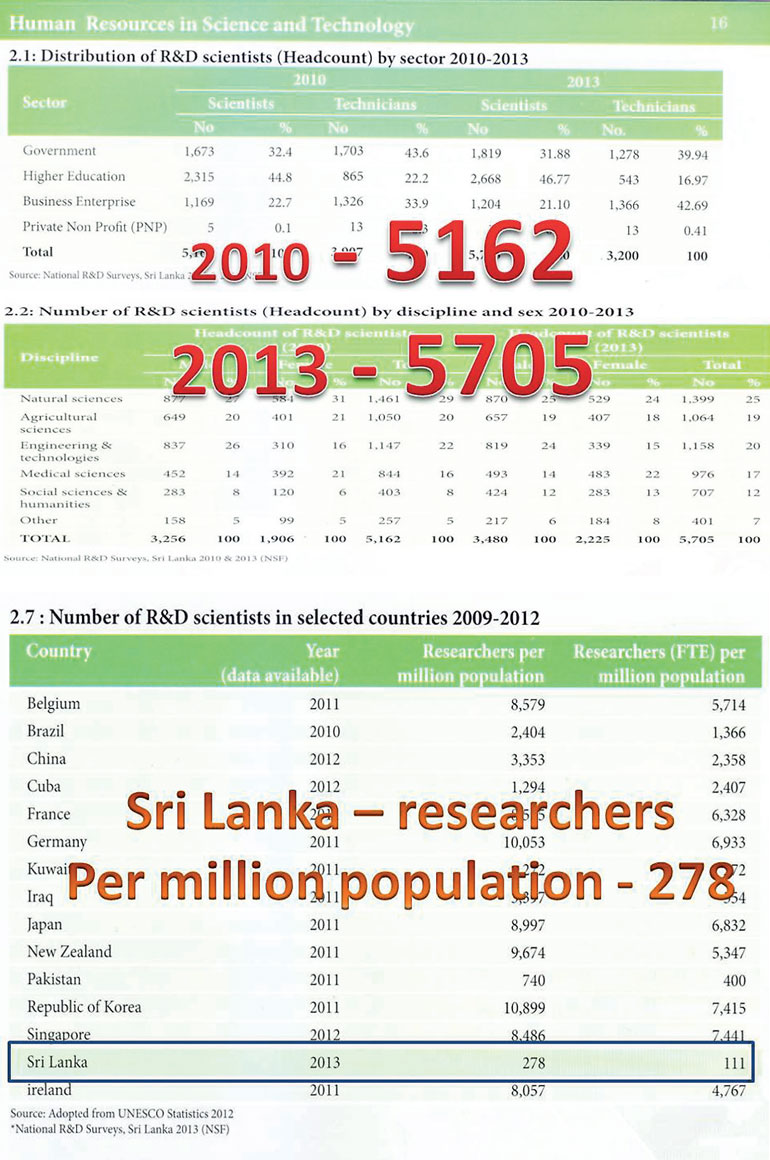
Trunk trouble for jumbo
A tusker who frequents the Sithulpauwa Rajamaha Viharaya in Kataragama had to go without food or water for over two days after its trunk got stuck in its tusk. However, Veterinary surgeon Dr. Ananda Dharmakeerthi and his team helped the animal to retrieve its trunk and all was well. Pic by Rahul Samantha Hettiarachchi.
Source : 22/01/2017 Sunday Times,See more at: http://www.sundaytimes.lk/170122/news/trunk-trouble-for-jumbo-225810.html
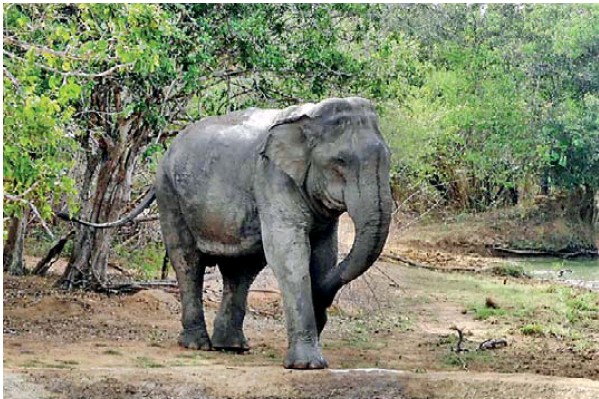
BEWARE OF WILD ANIMALS COMING INTO VILLAGES, WARNS OFFICIAL
The wild animals in the national parks in the Amapara District may roam into human habitats in the coming days if there were no rains, Asst. Director, Wildlife Conservation Ampara District D.M. Weerasinghe told the Daily Mirror
“The wild animals in the national parks in the district were facing a shortage of drinking water and food,” he said.He said that the animals in the Kumana, Maduru Oya and Lahugala National Parks were in a danger for want of drinking water.However, he said that there was adequate water for a couple of months, but the animals would roam into the villages in search of food.He said that attention of the private sector organizations would be drawn to the need of bowsers and other facilities to provide water to the animals.
He said the water supply system in the Kumana national park provided a skeleton supply of water that could not cover the demand.
Source :20/01/2017 Daily Mirror

Plans to set up natural gas hub in Trinco
Cabinet approval has been sought to establish a Liquefied Natural Gas (LNG) Hub terminal and Storage at the Trincomalee Port for export by Energy World International Ltd, a leading company headquartered in Hong Kong, it is learnt. It is also seeking approval to hand over a 30 acre land on lease for 30 years to the company. This global company submitted a business proposal first way back in 2012 to seek approval. However, the Attorney General observed that the scope of the project was in conflict with the Sri Lanka Electricity Act. Later, the Sri Lanka Ports Authority sought this Company to establish a joint venture with the local authorities for investment. The proposed investment is US $ 300 million. A Cabinet Appointed Negotiating Committee and a project committee will evaluate the proposal for this project and submit recommendations.(Kelum Bandara)
Source :20/01/2017 Daily Mirror,See more at: http://www.dailymirror.lk/122475/Plans-to-set-up-natural-gas-hub-in-Trinco#sthash.yAoCrCT7.dpuf
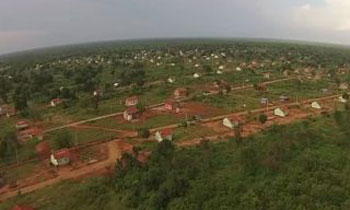
Action should be taken against those who deforest Wilpattu National Park.
Coalition to Protect Our National Heritage said yesterday if former Minister Wimal Weerawansa was remanded for misusing state vehicles, politicians and government servants who were behind the deforestation of the Wilpattu National Park should also be brought before the FCID and CID. Environmental activist Nayanaka Ranwella said the devastators of the environment should have been in prison for causing an irreparable loss to the environment and added that they were urging the government to implement the law against the culprits. “While Wimal Weerawansa was arrested for misusing state vehicles, politicians and government servants who destroyed Wilpattu National Park are at large. We can buy vehicles but we cannot repair the destruction caused to the environment,” he said. He told a news conference that more than 3, 400 acres of the Wilpattu Forest Reserve had been destroyed and that the deforestation was continuing under the present government as well. He urged the President as the Environmental Minister to mediate in resolving the issue as it would endanger the rare “Villu” eco-systems. Environmental Activist Sajeewa Chamikara said people from other areas were being settled in Wilpattu Forest Reserve for political advantage claiming that it was resettlement. “It is not resettlement which is happening in these areas. People from other areas are brought to these deforested areas on political requirements. Minister Rishad Bathiudeen is trying to justify his taking over of the forested areas,” he said. He said 280 acres of forested land was taken over by Minister Bathiudeen and Basil Rajapaksa by forcing the Forest Department to release the land during the previous government and added that over 1, 700 acres had been cleared illegally so far. “The Forest Department officials were helpless as they were unable to take action against them,” he said. (Ajith Siriwardana)
See more at: http://www.dailymirror.lk/article/-Action-should-be-taken-against-those-who-deforest-Wilpattu-National-Park-122423.html
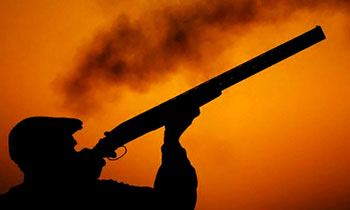
Man killed in shootout at Wasgamuwa National Park
A 38-year-old man was killed at the Wasgamuwa National Park during a shootout between wildlife officers and a group of hunters, who had allegedly entered the park last night, Police said. A wild life officer has also been arrested in connection with the shootout which took place when officials launched a search operation following a tip off. Police said the three individuals were asked to surrender but had opted to open fire. A suspect who was injured during the shootout had succumbed to his injuries after he was admitted to the Wilgamuwa Hospital. Investigations revealed that wildlife officers had used rubber bullets during the shootout.(M.W. Somaratne)
See more at: http://www.dailymirror.lk/article/Man-killed-in-shootout-at-Wasgamuwa-National-Park-122361.html#sthash.hAOSy4wu.dpuf
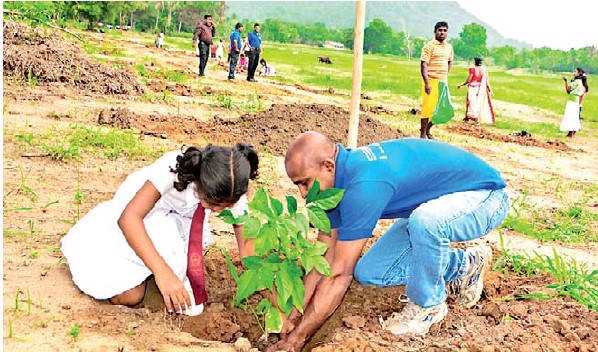
Local community plants 600 saplings to develop the Podiwewa ecosystem
The surroundings of the Podiwewa, a minor irrigation tank in Monaragala was a hive of activity recently as the villagers from Thimbirigas-ara in Buttala came together with a single intention in mind.
(FAO officer and a child planting a sapling . Photo Credits: FAO/JUDE Anton Raj)
The villagers, both young and old joined the Monaragala District Secretary D.S. Pathmakulasooriya and officials from the Department of Agrarian Developmentto plant saplings around the Podiwewa in a bid to develop the tank ecosystem. The Podiwewa is intertwined with the lives of 43 farmer families in Thimbirigas-ara as it irrigates paddy farms and Other Field Crop cultivations while also providing a water source for daily needs. Supported by the Food and Agriculture Organization of the United Nations (FAO) and the European Union, saplings such as Kumbuk, Tamarind, Mee and Karandawere planted on the upstream section of the tank. Palmyra saplings were planted along the downstream edgeof the tank bund.
“The saplings were provided by our villagers and theforest Department” said Mr. Gunadasa who is the President of the Thimbirigasara Farmersorganization. “We planted around 600 saplings in a one kilometer area.each farmer has now taken on the responsibility of nurturing around 10-15 of these plants.” The saplings that were planted in the upstream section of the tank (gasgommana) will eventually become natural wind barriers during high winds, reduce evaporation and erosion, and will protect the tank from illegal encroachments.
In Sri Lanka, the ecological segments of the village tank system play vital roles. The downstream reservation (kattakaduwa) is the stretch between the tank bund and paddy fields. It contains flora which acts as a downstream wind barrier, minimizes seepage and prevents polluted water containing salt and heavy metals from flowing into paddy fields. The soil ridge (iswetiya) of the tank diverts sediments/silt, thereby preventing soil erosion. The waterhole (godawala) in the tank inlets act as a source of drinking water for wildlife and livestock while trapping the sediments, which would otherwise flow into the tank. However most of theecological components of village tanks that have existed for centuries are disappearing. Encroachment for cultivation purposesand removal of trees for various uses are some of the main reasons. The cause stems from a lack of awareness on the importance of the tank ecosystem.
FAO Technical Officer (Monaragala District), Ranjith Pushpananda said, “Developing the ecosystem of irrigation tanks is crucial as tanks mitigate the effects of natural disasters such as drought and floods. For instance, the storage of excessive runoff water in tanks during heavy rains reducesflooding and the conservation of water for use in the dry season. Irrigation tanks also enhance the biodiversity. The importance of the tank ecosystem was shared with the villagers of Thimbirigasara. The villagers constructed the soil ridge of the tank and the waterhole prior to the tree planting initiative.”
The Podiwewa is currently being rehabilitated by FAO under the European Union Support to District Development Programme (EU-SDDP) which has a total financial envelope of EUR 60 million. Improvements to the irrigation channel and spillway of the Podiwewa, widening of the tank bund and improving the access road to the tank are ongoing. Once rehabilitation works are completed, the farmers of Thimbirigas-ara will conduct regular ordinary maintenance of the tank and will continue to conserve the tank ecosystem.
Gunadasa echoed “We became aware of how the environment helps us and the importance of protecting the tank and its surroundings. At a time when trees are being cut down and forests are being cleared, planting saplings on the tank bed of the Podiwewa is an example to villagers that depend on tanks. The future generation of Buttala will greatly benefit from it.”
Source :29/12/2016 Daily Mirror http://epaper.dailymirror.lk/epaper/viewer.aspx
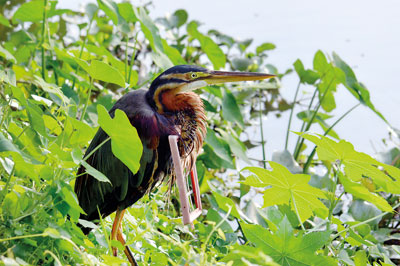
Don’t trash nature’s gifts, wildlife experts plead
(Birds; victims of careless garbage dumping by us humans. Pix by Sumith Bandara)
Reckless disposal of garbage in our localities can put precious bird life in peril as two recent incidents showed.Wildlife specialists are appealing to Sri Lankans to be a lot more considerate after rescuing two species of bird that endured the horrors of human encroachment of their habitat.
Herpetologist and wildlife photographer Mendis Wickramasinghe and two assistants Sumith Bandara and Saman waited until dusk last Sunday to go to the aid of a purple heron (karawal koka), which often feeds on fish in marshes and paddy fields, struggling to free its beak tangled in a plastic contraption.
Photos of its plight at Boralasgamuwa tank, caught the attention of social media users and drew the usual chatter.
Wickramasinghe and his aides freed the blue heron from its misery. They then checked for possible wounds and released the bird. The following morning they visited the location to give it a meal of fish, but the blue heron had other ideas and flew off to feed itself.Bandara said it was a happy outcome, but he pleaded with Sri Lankans to abandon destructive habits. “People need to be more careful when dumping waste,” he said.
But then two days later, he had to rescue another bird from similar circumstances.Being a keen wildlife photographer, Bandara again visited the Boralasgamuwa tank on Wednesday evening. He soon saw a yellow bittern (kaha metikoka) with its beak entangled in a net. Bandara noticed it was a discarded mosquito net.
As dusk approached Bandara and friend Amila Ranga waded into deep water and released the bird from the net. It was a risky exercise. The exhausted bird appeared disoriented and stood by for a few minutes before taking flight.Bandara also noted that strings used for kite flying have also become death traps for birds.
Source : Sunday Times http://www.sundaytimes.lk/161211/news/dont-trash-natures-gifts-wildlife-experts-plead-219744.html
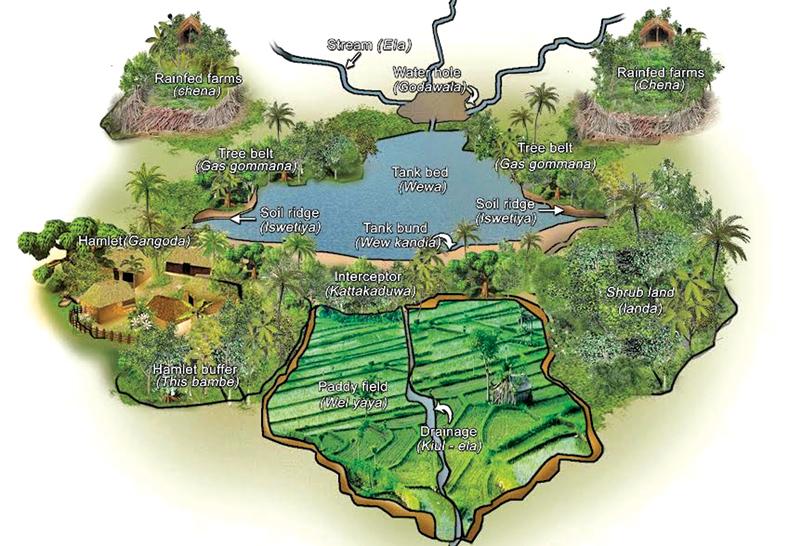
FAO, EU Help Develop Tank Ecosystem in Podiwewa
The environs of the Podiwewa, a minor irrigation tank in Moneragala was a hive of activity recently as the villagers from Thimbirigas-ara in Buttala joined the Moneragala District Secretary, D.S. Pathma Kulasooriya and officials of the Department of Agrarian Development to plant saplings around the Podiwewa to develop the tank ecosystem.
The Podiwewa is intertwined with the lives of 43 farmer families in Thimbirigas-ara as it irrigates paddy farms and other field crop cultivations while also providing a water source for daily needs.
Supported by the Food and Agriculture Organization of the United Nations (FAO) and the European Union, saplings such as kumbuk, tamarind, mee and karanda were planted on the upstream section of the tank. palmyrah saplings were planted along the downstream edge of the tank bund.
The saplings were provided by our villagers and the Forest Department,” said Gunadasa, the President of the Thimbirigas-ara Farmers Organization. “We planted around 600 saplings in a one kilometre area. Each farmer has now taken on the responsibility of nurturing around 10-15 of these plants.”
The saplings that were planted in the upstream section of the tank (gas gommana) will eventually become natural wind barriers during high winds, reduce evaporation and erosion, and will protect the tank from illegal encroachments.
In Sri Lanka, the ecological segments of the village tank system play vital roles. The downstream reservation (Kattakaduwa) is the stretch between the tank bund and paddy fields.
It contains flora which acts as a downstream wind barrier, minimizes seepage and prevents polluted water containing salt and heavy metals from flowing into paddy fields.
The soil ridge (iswetiya) of the tank diverts sediments/silt, thereby preventing soil erosion.
The waterhole (godawala) in the tank inlets act as a source of drinking water for wildlife and livestock while trapping the sediments, which would otherwise flow into the tank.
However, most of the ecological components of village tanks that have existed for centuries are disappearing. Encroachment for cultivation purposes and removal of trees for various uses are some of the main reasons. The cause stems from a lack of awareness on the importance of the tank ecosystem. FAO Technical Officer (Moneragala District), Ranjith Pushpananda said, “developing the ecosystem of irrigation tanks is crucial as tanks mitigate the effects of natural disasters such as drought and floods.”
“For instance, the storage of excessive runoff water in tanks during heavy rains reduces flooding and conserves water for use in the dry season. Irrigation tanks also enhance biodiversity. The importance of the tank ecosystem was shared with the villagers of Thimbirigas-ara.
The villagers constructed the soil ridge of the tank and the waterhole prior to the tree planting initiative,” he said. Gunadasa said, “We became aware of how the environment helps us and the importance of protecting the tank and its surroundings.
At a time when trees are being cut down and forests are being cleared, planting saplings on the tank bed of the Podiwewa is an example to villagers that depend on tanks. The future generation of Buttala will greatly benefit from it.” The Podiwewa is being rehabilitated by FAO under the European Union Support to District Development Programe (EU-SDDP) which has a total financial envelope of EUR 60 million. Improvements to the irrigation channel and spillway of the Podiwewa, widening of the tank bund and improving the access road to the tank are ongoing. Once rehabilitation works are completed, the farmers of Thimbirigas-ara will conduct regular ordinary maintenance of the tank and will continue to conserve the tank ecosystem.
Source : 18/12/2016 Sunday Observer http://www.sundayobserver.lk/2016/12/18/business/fao-eu-help-develop-tank-ecosystem-podiwewa
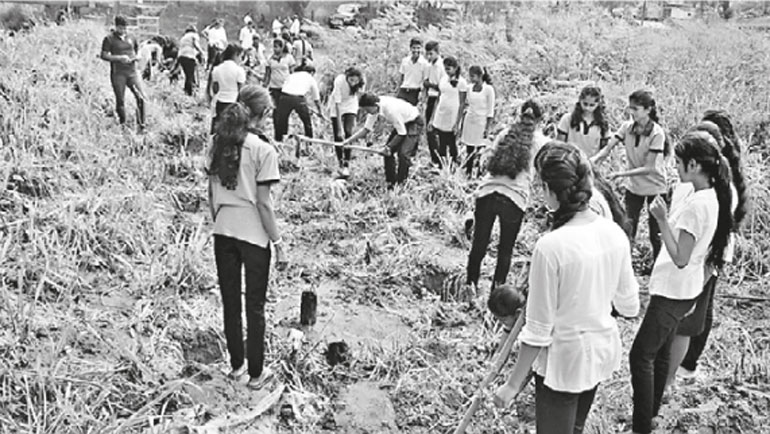
1,000 saplings planted to mark CTC’s Annual Tree Planting Program
Plant a Tree – Save Planet, the annual tree planting program organised by the Ceylon Tobacco Company PLC (CTC) was held at the banks of Polgolla Reservoir in November. 1,000 saplings were planted to mark this annual event by 200 volunteers representing CTC, Mahaweli Authority, Central Environment Authority, Sri Lanka Army, Sri Lanka Police and the Pahatha Dumbara Technical College.
Speaking about the annual project CTC’s Supply Chain Director Rukshan Gunethilake said that this annual activity brings together employees and stakeholders to mark the National Tree Planting Week; “Through this activity CTC is not only taking part in a national event but are also creating the awareness among the community of the importance of conserving the forest cover that will in return protect the water catchment areas.”
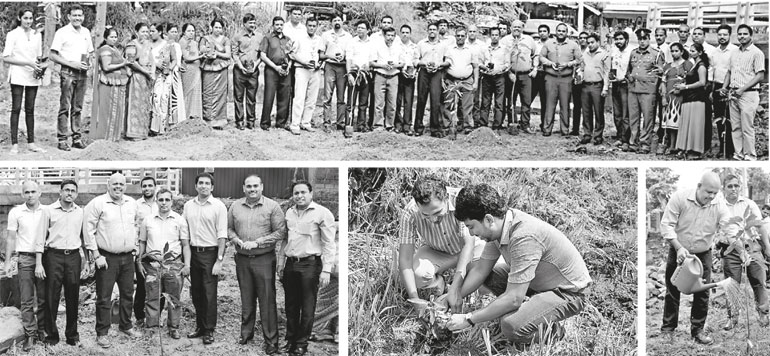
The tree planting project was carried out on a plot of land which was selected based on the environmental requirement. The company believes that programs of this nature support the national drive to increase forest cover in Sri Lanka. CTC hopes that this project would help reforest and conserve the environment around the Polgolla Reservoir area and in return nurture the water catchment areas bordering the Mahaweli River.
As a responsible corporate entity, CTC believes in working together with communities and strengthening relationships with the agriculture and farming communities of Sri Lanka by continuing to support them through their core operations and sustainability initiatives. The Tree Planting Program ‘Plant a Tree – Save Planet’ supports the Company’s Sustainability Agenda as well as the Environmental Pillar of Sustainable Tobacco Production (STP) standards.
Source :10/12/2016 Daily FT //www.ft.lk/article/585114/1-000-saplings-planted-to-mark-CTC-s-Annual-Tree-Planting-Program#sthash.wNR6dHRq.dpuf
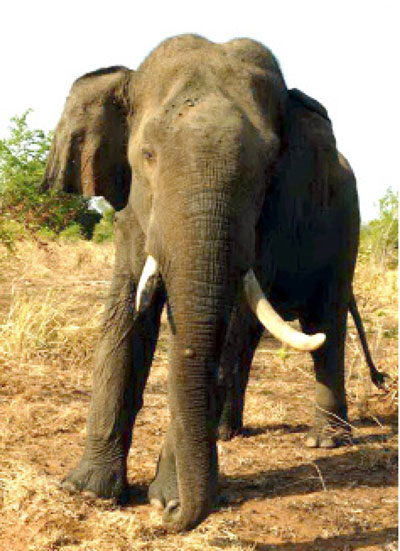
Researchers and elephants – we have a problem!
ohn Dewey said that “every great advance in science has come from a new audacity of imagination” and these acts of imagination have to come from researchers. The numbers for Sri Lanka appear to be really worrying as the critical mass necessary is seriously missing.
Research is investing money to generate knowledge. Today in Sri Lanka the country’s investment on R&D is estimated to be around 0.16% of GDP. This is not adequate and well below that of a LDC. Yet on actual terms some millions of US Dollars are spent on research and development.
In the public space there are around 66 research institutes and university faculties in the area of science and technology. These are spread over 21 line ministries. There is a trend of private sector research in science and technology growing too. As there is clearly a business intention when private sector R&D is taking place, there is much less visibility of quantitative data on private investments.
Scarcity of researchers
Innovation step returns money back based on the knowledge generated through investments. The first step is vital as innovation depends on research and research is primarily a researcher activity. Hence the importance of research is undisputed and the whole process depends on persons with integrity, patience and creativity. Researchers can come from many strata with research academics at universities and senior research scientists at institutions crowding the apex of positions.
There is no accurate current estimate of number of researchers (both full time and part time) and the process of estimation is not yet dynamic. Hopefully the Sri Lanka Innovation Dashboard which bagged the first place in recent e-Swabhimani awards in the Government category will provide us with a dynamic display of status. However, individual participation is vital to make the process a success.
Sri Lanka Innovation Dashboard expects to capture research and researchers and inventors at all levels. As per the National Science Technology and Innovation strategy document, the total number of all available researchers with PhDs in Universities at present in Sri Lanka is 1,160 (of which only less than 300 are currently supervising research degrees – producing an average of 20-50 research degrees a year, by 16 universities). This number of supervisors is inadequate to train the target of 20,000 researchers.
The larger number comes from UNESCO’s identified rule of thumb of number of researchers required to an economy of Sri Lanka which is a lower middle income economy. The value indicated for Sri Lanka is 278 in the 2013 estimate. Compare the position of Singapore with over 8,000 per million of population. There is definitely a scarcity of researchers.
We give great attention to elephants. An entire industry more or less depends on the presence of these majestic animals and religious places too cry foul when they cannot get the numbers necessary to parade on streets. All the interest however is not based on the welfare of the animals. The statistics indicate that the number of elephant population to be from 5,000-5,600 as per Department of Wildlife data. It appears that we more or less have the same number of elephants as researchers! While we really worry over the decline of the elephant population, researchers have been given scant attention. The repercussions are not on just one industry but on the whole economy.
Indian example
I place this story that is circulating with a purpose. Also being at Indian Institute of Science which is a Postgraduate Research University (modelled as per the John Hopkins University of USA) I know the relevance and the contribution that it makes. This is where high-end research is carried out within the country as in this case for India.
“Jamshedji Nusserwanji Tata was once, travelling to Europe. As he stood there, at the door of his First Class Cabin in the steamliner, he noticed a lot of activity on the lower decks of the ship. On inquiring, he learned that a great Indian Saint, Shri Swami Vivekananda, was on board the same ship. Out of genuine respect and curiosity, J.N. Tata decided to pay a visit to the great saint.
“Swami Vivekananda had, of course, heard about the respected industrialist. As the conversation grew J.N. Tata explained that he was on his way to Germany. ‘I have with me sacks of soil: From various parts of India. I am taking these samples of soil to Germany. I wish to know if iron can be extracted profitably from any of these districts,’ said J.N. Tata to the Saint, to which Swami Vivekananda replied, ‘Well, Sir, even if these sacks contain iron-rich soil, do you honestly believe that the Europeans will tell you the truth? You must understand that no/none of the European Nations wish to see a strong/steel-rich/economically independent India. The soil is probably rich in iron-ore but the sad truth is all you will get from your inquiries across Europe is disbelief and pessimistic reactions.
“Needless to say, having interacted with several Europeans J.N. Tata knew this to be true. Swami Vivekananda continued, ‘Why don’t you start an excellent/up-to-date research facility and college here in India? Why don’t you train some good Indian youngsters to identify soil and conduct these tests and find ways of profitably extracting metals? It may seem like a wasteful; burdensome expenditure right now, but in the long run – it will save you many trips to Europe and you can have the assurance of knowing the truth quickly – rather than taking multiple opinions due to doubt.’
“As he could clearly sense J.N. Tata’s mood was in acquiescence, he further elaborated, ‘Seek an audience with the Maharaja of Mysore H.R.H. Wodeyar. Though a subordinate of the British, he will definitely help you in every way he can. H.R.H. Wodeyar has been generous enough to sponsor my own trip to Chicago to attend the Parliament of Religions.’ As soon as he returned to India, J.N. Tata headed straight for Mysore. And indeed, H.R.H. Chamraja Wodeyar did not disappoint him. The King granted 370 acres of land for the setting up of the Research Facility and College that J.N. Tata had envisioned and it was named the Indian Institute of Science.”
What is clearly indicated is most of the times crucial answers to your questions one needs to source from within. Thus when countries have critical mass of researchers there is the generation of knowledge and if the rest of the eco-system is present there is the option of investment of knowledge to generate revenue to the economy. These simple representations indicate the urgency for us in addressing this dearth.
This situation cannot be rectified overnight. Starting from higher purposeful investments by the Government, the task has to move forward within a defined timeframe. The political leadership has to come to a clear understanding of this national need and its potential returns upon implementation.
Research to the fore
When research is at frontiers there is the blurring of discipline boundaries. Today there is so much excitement at subject interfaces. The three dominant technology areas – information technology, biotechnology and nanotechnology – are spawning many an area in areas of convergence. Almost unique developments are prophesied where all three converge. Bioinformatics was convergence of biotechnology and information technology.
Nanobiotechnology and bionanotechnology areas result from the interface of bio and nanotechnologies. Quantum computing is when nanotechnology and information technology interacts. The area where triple convergence occurs is an exciting frontier to be considered. One must admit that there is a fourth area that is emerging – neurotechnology (cognitive sciences) which push the boundaries even further.
Sri Lankan researchers through networking can and should engage in frontier research. If we strategically understand the research space there are areas where not only we can participate but perhaps lead too. Biomimetics offer significant opportunity. The combination of indigenous medicinal systems with modern science is another area. If Sri Lanka understands the value of strategic investments as had been shown with Sri Lanka Institute of Nanotechnology (SLINTEC) host of other areas definitely opens up with possibilities – advanced nanomaterials and applications, information technologies in interfaces, renewable energy systems (biogas, microbial fuel cells, etc.).
With so many opportunities for engagement one should have an ecosystem which encourages and rewards young researchers to take on the seemingly impossible than stick to well traversed pathways. There again there is a responsibility on the Government in understanding the role of researchers in propelling the position of the country when a critical mass of researchers really get themselves engaged on frontier areas
Source Daily FT 08/12/2016 : http://www.ft.lk/article/584607/Researchers-and-elephants-%E2%80%93-we-have-a-problem-#sthash.PRgfdHvC.dpuf












